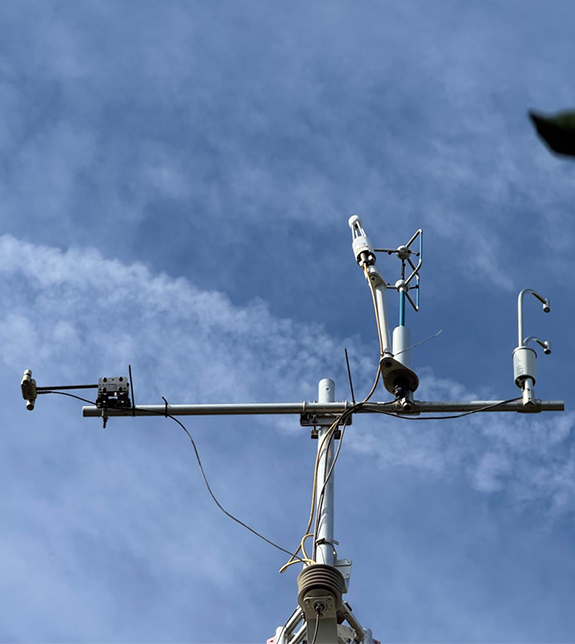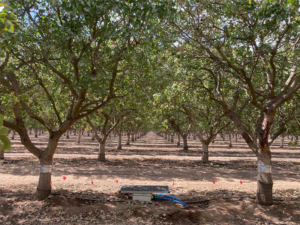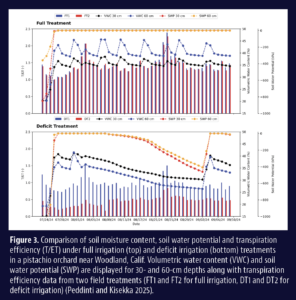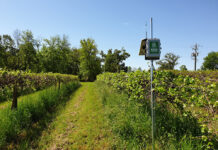
California’s orchards are an agricultural marvel, producing an incredible variety of fruit and nut crops that are enjoyed across the nation and around the world. From the sprawling almond and pistachio orchards of the Central Valley to citrus and stone fruits in coastal regions, growers rely on sustainable management of resources to maintain productivity. Among these resources, water stands as the most critical and increasingly scarce resource. With multi-year droughts, increasing water regulations and growing competition for water resources, the efficient use of water has become a cornerstone of sustainable orchard management.
In this context, precision agriculture offers a path forward. By employing advanced monitoring technologies and data-driven approaches, growers can achieve a level of irrigation management that was previously unimaginable. Precision agriculture enables growers to optimize water application by delivering the right quantity at the right time and in the right place where it is most needed. This targeted approach to irrigation not only improves water use efficiency but also enhances tree health, reduces costs and minimizes the environmental impact of agricultural operations.
Understanding Orchard Water Use with Advanced Tools
One of the key tools in precision agriculture is the eddy covariance system (Fig. 1). This advanced technology measures the exchange of water vapor and carbon dioxide between the orchard and the atmosphere. By providing real-time data on evapotranspiration (ET), the combined loss of water from the soil and plants, eddy covariance systems help growers understand exactly how much water their orchard is using at any given moment.
This information is crucial for designing irrigation schedules that align water delivery with the actual needs of the trees. Such a tool is particularly valuable in large orchards, where water requirements can vary significantly across the field due to differences in soil type, tree age or microclimatic conditions. Previously, eddy covariance systems were too expensive and complicated to be integrated in commercial irrigation applications. However, recently, the new ET sensor, LI-710 (shown on the right in Fig. 1), has become available, providing similar data and functionality for growers at a lower cost compared to the traditional eddy covariance systems.
Monitoring Tree and Soil Water Status for Optimal Irrigation
Complementing the eddy covariance system are ground-based monitoring tools like sap flow sensors and soil moisture sensors (Fig. 2). Sap flow sensors are installed directly on the tree trunks to measure the movement of water through the xylem, providing a direct indication of how much water the tree is using. Meanwhile, soil moisture sensors (Fig. 2) measure the volumetric water content of the soil, providing information about the amount of water stored in the soil. In contrast, soil water potential sensors measure the energy which water is being held in the soil, offering insights into the availability of water for plant uptake. Both types of sensors are valuable for optimum irrigation management.
Together, these tools give growers a detailed picture of the water status in their orchards, from the soil to the trees and into the atmosphere. For example, soil water potential sensors can indicate when the soil is too dry for tree roots to extract water, signaling the need for irrigation. Conversely, sap flow measurements can help growers avoid over-irrigation, which not only wastes water but can also lead to problems like nutrient leaching and waterlogging of the root zone.
Comparing Irrigation Strategies for Better Decision-Making
The benefits of precision irrigation become especially clear when evaluating various irrigation strategies. Figure 3 presents the comparative outcomes of two irrigation methods: full irrigation and deficit irrigation.
In the full irrigation treatment, trees received enough water to meet their entire evapotranspiration demand, ensuring optimal growth conditions. Soil moisture levels in this treatment remained stable throughout the season, with trees maintaining high transpiration rates and minimal water stress. This approach is ideal for maximizing productivity, but it also requires a significant amount of water, which may not be sustainable during drought years or under strict water allocation limits required under the Sustainable Groundwater Management Act in some regions of California.
In contrast, the deficit irrigation treatment deliberately imposed mild water stress on the trees by providing less water than their full evapotranspiration demand. This strategy resulted in lower soil moisture levels and reduced transpiration rates. However, the trees were still able to maintain reasonable productivity levels, demonstrating deficit irrigation can be a viable strategy for conserving water without sacrificing too much yield.
The choice between these two approaches depends on growers’ specific circumstances, including water availability, crop type and economic considerations. For many growers in the Central Valley, deficit irrigation offers a practical way to reduce water use while maintaining orchard productivity during challenging conditions such as multi-year droughts.

Adapting Irrigation Practices to Orchard Conditions
In practice, implementing precision irrigation requires more than just installing sensors and collecting data. It requires incorporating this information into a comprehensive management plan customized to the specific conditions and needs of each orchard. Trees in sandy soils, for example, may require more frequent but smaller irrigation events, while those in clay soils may benefit from less frequent but deeper water applications. In a similar manner, young trees with limited root systems often have water requirements that differ from those of fully grown trees.
Precision agriculture tools can help growers account for these differences and tailor their irrigation practices to meet the specific needs of their orchards. By combining real-time data with an understanding of soil and tree dynamics, growers can create irrigation schedules that maximize water use efficiency and optimize tree health.
Economic and Environmental Benefits of Precision Irrigation
The economic benefits of precision irrigation are significant. Efficient water usage allows growers to lower both their water expenses and the energy costs linked to pumping. In addition, healthier trees that receive the right amount of water are more productive and less susceptible to diseases, resulting in higher yields and better-quality fruit or nuts. These advantages can help compensate for the upfront costs of precision agriculture technologies, making them a valuable long-term solution for growers.
Beyond the economic benefits, precision irrigation also has important environmental implications. By reducing overirrigation, growers can minimize the risk of nutrient leaching, which occurs when excess water carries fertilizers beyond the root zone and into groundwater or surface water bodies. This not only helps protect water quality but also reduces the need for additional fertilizer applications, saving both money and resources. Furthermore, by conserving water, growers can reduce their overall water footprint, contributing to the sustainability of California’s agricultural sector.

Overcoming Challenges and Looking Ahead
The adoption of precision agriculture is not without its challenges. For many growers, the upfront cost of purchasing and installing advanced monitoring equipment can be a barrier. Furthermore, understanding and utilizing the data generated by these tools often involves a learning curve, as growers adapt it to their daily management practices. However, as more growers adopt these technologies and share their experiences, the knowledge base around precision irrigation continues to grow, making it easier for others to follow suit.
Educational initiatives and outreach programs are essential for encouraging the adoption of precision agriculture practices. Workshops, field days and demonstration projects can help growers see these technologies in action and understand their potential benefits. Collaborations between researchers, industry stakeholders and growers are essential for developing practical solutions that address the real-world challenges faced by California’s orchard managers.
Precision Agriculture as a Long-Term Solution
Looking to the future, precision agriculture is likely to become even more sophisticated with the integration of artificial intelligence, machine learning and advanced data analytics. Predictive models that use data from eddy covariance systems, sap flow sensors and soil moisture probes could provide growers with real-time recommendations for irrigation scheduling, taking the guesswork out of water management. Similarly, remote sensing technologies, such as drones and satellite imagery, could complement ground-based monitoring tools by providing a broader perspective on orchard health and water use.
As these technologies continue to evolve, they will play an increasingly important role in helping California’s growers navigate the challenges of water scarcity and climate change. By embracing precision agriculture, orchard managers can ensure the long-term sustainability of their operations while maintaining California’s position as a global leader in fruit and nut production.
References
Peddinti, S. R., Gordon, P., Oker, T., Marino, G., and Kisekka, I., 2025. Evaluating transpiration efficiency and soil moisture dynamics under varying irrigation regimes. Under preparation.


















